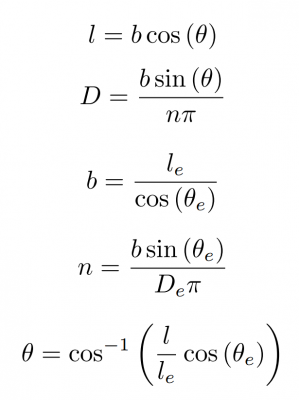Design
The basic choices for designing a McKibben Actuator are the length, diameter and winding angle (θe). The length and winding angle determine how far the actuator will contract. The winding angle is the angle of the fibers when the actuator is fully extended. As the actuator contracts, the angle increases until some point before 54.7o. We've been able to achieve about a 20% contraction with a 20o winding angle. Here are some things to keep in mind when designing your smart braid:
- Smaller winding angles increase the stress on the fibers.
- Larger winding angles lead to a smaller overall contraction but lower stress on the fibers.
- Larger diameters create more force during the contraction.
- The force will be greatest when the actuator is fully extended and will decrease as the actuator contracts.
The Smart Braid introduces additional design choices about the wires. The wires need to be chosen so that the stress in the wires is not too great and their resistance is low enough to measure the inductance of the sensor. A relatively large diameter wire can achieve these goals.
Braid Model
We can model the way that braid will contract by adapting equations presented by Chou and Hannaford.

The subscript "e" refers to the condition of the braid in its fully extended, unpressurized condition. "b" is the length of the helices that make up the braid. "n" is the number of turns each helix makes around the axis. "θ" is the angle that the wires of the braid make with the long axis. "D" is the diameter of the braid. "l" is the length of the braid.
Design Calculator
Smart Braids need to be designed to provide both sensor and structure for the actuators they surround. It can be difficult to balance the demands of actuator design with Smart Braid performance. To aid in this design process, we've created a design calculator (attached to this page). The design calculator allows you to make your design feasible. It makes sure you can fit the wires around the tube and checks the forces on the wires to ensure they won't break. If you plan on measuring inductance by using a capacitor, it lets you know if you're choice of capacitor will result in an oscillating circuit with a measurable frequency.
| smart_braid_design_caluclator_0.xlsx | 12 KB |